Alone on a mountain: the true story of Flight 349

An artist's rendition of how Flight #349 might have appeared before it flew into the southeastern flank of Bucks Elbow Mountain in Albemarle County, killing 26 of the 27 people aboard.
–painting by Dave Paulley, digitally altered with permission
It was the fall of 1959, and Scarsdale, New York teenager Janet Silberman had been planning to accompany her parents, a top cigar company executive and an avid photographer, on their trip to Virginia. Her younger brother had just begun his freshman year at Staunton Military Academy, and the Silbermans envisioned a getaway to see him as autumn foliage erupted in the Shenandoah Valley.
But when a handsome Yale student invited the 16-year-old Janet to a football game, her plans for the weekend changed. She was in the stands in New Haven on Saturday, October 31, when a close family friend, who was also the family lawyer, suddenly appeared.
"I didn't realize you went to Yale," she wisecracked.
"I'm sorry, Janet," replied her grim-faced friend. "But the game is over for you. The plane your parents were on is missing."
Fifty years ago this month, near the Blue Ridge in Western Albemarle County, a commercial airliner disappeared while carrying a crew of three and 24 passengers. Only one survived.
A plane old DC-3
Until Friday, October 30, 1959, Charlottesville had never been the center of a search for a missing plane, and Piedmont Airlines had never had a crash.
A regularly scheduled flight out of Washington with stops in Charlottesville and Lynchburg before its final destination in Roanoke, Flight 349 was a favorite for businesspeople and affluent vacationers.
Just a night before the new moon, there was little light on this cloudy but otherwise unremarkable autumn night. Flight 349 was running 19 minutes behind schedule when it took off from National Airport at 7:49pm.
As the plane taxied along runway 33, a union organizer on his way back to his home town of Clifton Forge tapped Ruth Silberman on the wrist and pointed out a gleaming nighttime view of the Washington Monument.
He couldn't have known just how much Mrs. Silberman might appreciate the scene. In fact, the adventurous mother of two and amateur photographer had once taken an unpressurized plane ride over Rio de Janeiro to snap a photo of that city's giant statue of Christ. On this night, however, no camera in hand, she simply agreed politely.
That was the last time he spoke to his fellow passengers.
Twenty-four passengers
Further up in the cabin, the only other woman aboard the plane, Lynchburg resident Marguerite Whitehouse, was returning with her husband, Lawrence, from a trip to New York City that combined shopping for her with business for him. The Whitehouses were well known in Lynchburg, as, along with another family, they owned the company that made ChapStick. While trips to the big city were common for the wealthy couple, their grandson says they usually took the train.
Then living in New Jersey, a young Radford native was returning home for his grandmother's funeral.
A quartet of engineers was heading back to Babcock & Wilcox, the Lynchburg-based nuclear components firm. A trio of DuPont employees who'd been in Philadelphia were returning to Waynesboro.
Also on the flight was Jimmy Helms, the 32-year-old veteran of the UVA Drama scene, on his way home from a conference.
Other passengers included a pipeline engineer going to see his son in Charlottesville, a pair of textile executives making a sales call in White Sulphur Springs, and a former Nelson County School Board member who ran the American Cyanamid plant in Piney River.
The last seat
If it now looks antiquated, the DC-3 was the cutting edge of aviation when introduced in 1936. Overnight, it transformed the airline industry by making cross-country flight practical for the first time.
Prior craft, such as the Ford Trimotor, had hard wicker seats, no sound-proofing, and they couldn't fly long distances– such as New York to Chicago– without stopping to refuel, says Gloria Dalton of the Carolinas Aviation Museum.
"The DC-3 changed everything," says Dalton. "It was the height of luxury."
With a pair of Pratt & Whitney engines, the DC-3 could move up to 24 passengers with its quieter cabin, individual overhead lighting, and– in the days before airplane air-conditioning– a then-novel passenger-controlled air-circulation system.
Even with its audacious reliance on just two engines, the McDonnell Douglas vehicle had proven so dependable that over 10,000 were manufactured, mostly for the military as troop and equipment transports. Among these was ill-fated plane number N55V.
Three years after the end of World War II, in the growing North Carolina city of Winston-Salem, a new airline was born. Piedmont had every reason to tout a safe fleet and pilots, as the War's end had unleashed thousands of highly-trained flyers and a veritable armada of aircraft. Piedmont's first fleet was 100 percent DC-3s.
By the time of the crash, Piedmont had moved into the jet age, but the 15-year-old "Buckeye Pacemaker" had flown 26,339 hours without serious incident.
Boarding
By Friday at 7:30pm, the time of scheduled departure, 23 of the plane's 24 passenger seats had filled. An engineering equipment rep who lived in Ivy, Robert C. Ashcom, had a ticket to get home for that flight, but he was delayed, so one of two standbys would take his place.
That lone empty seat was located at the right rear of the cabin. Unlike the port side chairs, which were arranged in pairs, each starboard seat was on its own.
At 7:49pm, the cabin door closed, and Phil Bradley, the union man who'd left home on Monday, must have felt relieved. He got the seat.
Something in the sky
The world in 1959 was a different place. Dwight Eisenhower was president, but as the Charlottesville Daily Progress was reporting that week, a dashing young Senator from Massachusetts was gaining traction in the wide-open presidential race just a year away. Local gossip centered on the recent opening of Charlottesville's first suburban strip mall, Barracks Road Shopping Center, where a Kroger grocery had already debuted with multi-week fanfare, including a massive searchlight to sweep the skies.
On the night of the fated flight, a UVA undergrad named Rey Barry was outdoors in the broadcast booth at Albemarle High School. A novice radio reporter for AM station WCHV, Barry was providing color commentary for the Friday night football game between the Albemarle Patriots and the visiting Waynesboro Little Giants.
From the school on Hydraulic Road, Barry recalls, he could see the beam from the searchlight, washing the cloudy sky from a mile and a half away. But the festive light may not have been the only unusual thing moving overhead.
Atop the bleachers and walled off from the din of the stands, Barry says that around 8:30pm he detected the sound of an airplane above the cloud ceiling. A plane six miles south of the Charlottesville Albemarle Airport and heading west made no sense to Barry.
"We heard a plane flying low from east to west," says Barry. "That's a route, in those days, that no commercial plane ever flew."
Barry couldn't get the sound of the plane out of his head, so when he returned to the station around 10 o'clock, he decided to call the airport to see if a plane were lost. Getting a terse "no comment," he realized that he was on to something.
Final approach
Although the crew was cruising under instrument flight rules above an overcast layer, at least one passenger– a frequent-flyer– at 4,000 feet up, could see the usual landmarks such as the lights of Culpeper, where an older brother was stationed as a state trooper.
Ahead in Charlottesville, according to the latest weather report, there was a broken layer of clouds at 1,500 feet with 10 miles of visibility.
The frequent flyer, who had seen the glow of the Kroger searchlight on a prior flight, allegedly saw it again illuminating the clouds.
The cabin lights were lowered, and passengers were instructed to fasten seatbelts and extinguish their cigarettes in preparation for landing. They could feel the pull of gravity as the plane began its descent.
The passenger was expecting a little swing to the left and then a right turn of just over 180 degrees for the final approach to the airport, something pilots call their "procedure turn," the last move before landing.
But aboard the plane, something didn't seem right.
"It didn't make one turn," the passenger would later say. "It made several turns– a couple of various and sundry turns."
Was the pilot in search of the runway? Could a commercial plane really get lost?
When the Kroger searchlight appeared for a second time under the right wing, the flyer figured that the bad weather simply meant Charlottesville was going to be bypassed for the next stop, Lynchburg.
Perhaps George Hicks, the flight attendant (or purser as he was titled), had the same idea, as he began arranging a tray and pouring four or five cups of coffee.
Then came an unmistakable sound that reverberated through the cabin: the lowering of the landing gear.
The plane continued its descent, and the vehicle began turning again. By this time, Flight #349 should have already landed.
Its final move must have been a starboard turn because, according to the government report, the right wing was dipped about 10 degrees, and the plane was heading north-northwest, as if nearing the end of the procedure turn.
A group of passengers at center-left in the cabin were laughing. And then it happened.
The frequent flyer instantly recognized the sound of tree branches brushing the right wing and glanced at his wristwatch. It was 8:40pm.
The laughter ceased as the plane began yawing to its right through the thick canopy of limbs and leaves. The trees responded by progressively shearing off the right wing.
Next, according to the government report, the fuselage began rolling to the right. Finally, after hurtling 144 feet through the forest, the vehicle lost its left wing as it nosed into the rocky slope of Bucks Elbow Mountain.
A reporter's suspicions
Driving home from the radio station around midnight, the young reporter decided to pursue his hunch. Then living north of town off Proffit Road, Rey Barry swung by the airport and quickly spotted enough commotion to confirm his suspicion.
In those days, besides covering local sports, WCHV was a music station. Whatever news it carried came out of teletype machines from the Mutual and ABC radio networks. That is, until October 30, 1959 when the 22-year old Barry smelled a scoop.
"I dispatched myself to this news assignment," says Barry, "but I had no tape recorder– just a pad."
After a hectic Friday night at the airport phoning in reports about fearful relatives and a search with few clues, Barry stretched out in the terminal and went to sleep.
The next morning, having convinced a helicopter crew that they needed someone who knew the local terrain, Barry secured a spot.
But it was fruitless amid the fall foliage which dotted the landscape in a cacophony of colors. As big as a DC-3 might sound going over a football game, in a search spanning a four-county area and hundreds of square miles, it was a tiny speck on the forested, mountainous terrain.
The search is on
By the time the fuselage reached the ground, it had been ripped apart. Although the cockpit was practically obliterated by the impact, the nose itself was 40 feet up in a tree above the rocky, densely forested mountain.
A visitor to the site was struck by the fact that, besides the horrific human carnage, every body was now shoeless.
It was a time before many commercial airliners were tracked with radar or carried a distress beacon or the now-standard "black box." And although Russia had stunned the world two years earlier by launching Sputnik, the satellite-driven Global Positioning System, or GPS, was still decades away.
No one knew where Flight 349 had gone.
There were scattered reports coming in from across Central Virginia of a low-flying plane that night. State Trooper Felix A. Bradley Jr., based in Culpeper, was particularly upset. His younger brother, Phil, was on that plane.
'Angry waves'
Phil Bradley was a native of Clifton Forge, who gave up an apprenticeship with the C&O Railway to join the Navy during World War II. Aboard the S.S. George E. Badger, he ferried men and machines– including 60-inch searchlights– across the English Channel on D-Day to the beaches of Normandy.
After college, he turned his attention to helping the working man as a labor organizer for the International Association of Machinists. Returning from a multi-day AFL-CIO meeting in Oklahoma City, he had an extended layover in Chicago's O'Hare Airport, where he bought a copy of Exodus, Leon Uris's fictionalized account of the settlement of Israel. But after spending much of the flight watching the lights of towns along Route 29, he'd read only 13 pages by the time things went awry.
Since the passengers had been told to prepare for landing, they were strapped in. But the same couldn't be said for their seats; all 24 were ripped away from the floor.
Something else happened at impact: a giant hole opened up nearly the entire right side of the passenger compartment. Seats and humans were tumbling through the hole.
One passenger remembers getting smacked in the face by the ground as he and his seat rolled. He spat out a tooth. The last thing he remembers before impact was a "roaring sound like an ocean of angry waves breaking upon a beach."
That passenger was the union organizer from Clifton Forge, Phil Bradley.
A cheering crowd
"The wings started hitting the trees, and then I started ducking," says Bradley. "They were all laughing, and then– whammo– we hit that mountain."
While about half the victims piled up inside the fuselage, 33-year-old Bradley was among those flung through the hole and onto the rocky mountain.
"I hollered to see if anybody would respond– to see if anybody was alive."
There was no response except for a "high-pitched, blood-curdling howl," something he later ascribed to wildcats.
As Bradley lay immobilized in the dark, he called out again for survivors. Groping to establish his surroundings, he felt a muscular leg and knee. Like him, the passenger was still strapped into his seat– but when Bradley called out to him, he was met with silence.
Finally, Bradley prepared to stand.
"I checked myself for internal injuries and lacerations, and didn't find any. So I took my seat belt loose and started to get up, and that's when the first pain hit. My left foot was going opposite of my right foot." His left hip was badly dislocated.
Bradley reached into a pocket and retrieved an L&M cigarette and his lighter, but a whiff of aircraft fuel was enough to dissuade him.
Despite the presence of over 100 gallons of fuel on board, just two or three small fires erupted and then extinguished themselves.
A light rain began falling. While the two-tenths of an inch helped prevent additional fires, it was enough to soak clothing. The temperature fell to 43.
"This may not sound all that cold," says UVA climatology expert Jerry Stenger, "but without shelter this is indeed enough for hypothermia to set in."
As Bradley waited for help to arrive, he could hear the sound of a cheering crowd and a marching band. He could hear cars and an occasional train.
He thought he must be near Charlottesville and figured help would soon be on the way.
Bone-chilling
Bradley realized that initial search-and-rescue efforts would be hampered Friday by darkness. But Saturday morning held the prospect of rescue.
Unfortunately for Bradley, who didn't sleep all night, Halloween Saturday dawned as a diorama of death.
As he spat out another tooth dislodged by the prior evening's tumbling exodus, he could clearly see what surrounded him: shoes, luggage, countless pieces of jagged metal– and many of the 26 bodies.
A big black bear and her cub walked over, paused, and moved on. Bradley wondered if lighting a small fire would accelerate his rescue. Unable to move, and therefore unable to escape if it should spread, he decided against it.
By 11am, fog began to shroud the crash site and lasted until 2pm. Even after the fog lifted, he could only listen helplessly as rescue aircraft flew over– but never seemed to spot the rip in the trees through which he was peering.
Alone, injured, and hungry, Bradley was facing weather conditions that would, climate expert Stenger says, compound his misery and jeopardize his life. While Saturday's daytime temperature climbed as high as 60, it dropped to 47 that night. And while the first night had been calm, winds picked up on Halloween, with sustained winds of up to 32 miles per hour measured at lower elevations.
"On top of the mountain," says Stenger, "they would, no doubt, have been even higher, with stronger embedded gusts."
The second night's winds, Stenger notes, "would have been bone-chilling."
Though immobilized from the waist down, Bradley managed to grab a nearby blanket and hunkered down.
The CAB investigates
The inquest began immediately with teams from Piedmont and the Civil Aeronautics Board (predecessor to the National Transportation Safety Board) arriving in town even before the plane had been located. Two months later, the CAB convened two days of hearings at the Monticello Hotel (now a condo tower called 500 Court Square). Bradley was interviewed at bedside, as he was still recovering in the UVA Hospital from one of the worst hip dislocations they'd ever seen.
Although there were scores of locals who thought they heard something that night, testimony included claims from just four Western Albemarle residents.
Among them was Free Union raccoon-hunter named Gilmer Walton, who allegedly heard a plane "rattle the trees" over Sullivan's Mountain.
Miller School teacher Lillian G. Foster said she heard it from her home near the school.
There was an "awful noise," said Mrs. Virgil James of Crozet. "It woke me up and seemed to be coming right into me."
Crozet secretary Naomi F. Hicks said she was outdoors when she heard a sound like an explosion. "At first I thought it was dynamite," she was quoted in the Daily Progress. (Hicks noted that she passed her tip along Saturday morning to the wife of a state trooper and to the Albemarle Sheriff's office, but no one interviewed her.)
At this point, the off-course-plane/pilot error theory was moving full throttle, and several bits of evidence seemed to support it. For starters, the plane may have been in the air too long for a normal approach. Another factor was that "at least three persons at the airport specifically listening for Flight 349 stated they did not hear it."
The plane was found to be at its maximum allowable take-off weight, but as no adverse handling issues had been noted, the government moved in different directions.
Another sleepless night
For Bradley, Halloween might have held the prospect of rescue. Unknown to him or anyone else, he was lying on a southeastern flank of Bucks Elbow Mountain, just two and half miles from a bustling little town called Crozet. He could hear cars honking, dogs barking, and occasional human hollering. But not for him.
Sunday, November 1, dawned with clear skies. By this point, Bradley had been on the mountain for nearly 36 hours, and a new visitor brought the prospect of additional terror. A lone turkey vulture, so-named for its distinctive red head, swooped in and began staring at Bradley.
Within an hour, dozens of turkey vultures had arrived. Bradley, fearing that his eyes would be plucked out, picked up a stick and began swinging.
A glint in the trees
Perched inside an Air Force helicopter over Crozet in the early morning light of Sunday, Sergeant Robert A. Mondragon of Andrews Air Force Base, thought he saw a glint of sunlight on metal. Or maybe just a dead tree.
"I had 'em circle over again," he was quoted in a newspaper. "I could see no signs of life."
It was around 7:30am, and Phil Bradley would soon be on another journey.
About 30 minutes later, the first official to reach Bradley was Sergeant John Weis, who had come down from his Massachusetts station at Otis Air Force Base.
"I sure am glad to see you," Bradley reportedly told Weis. "I'm all right."
But according to Barry, it was actually he, the youthful newsman, who made the first– if almost accidental– land contact. He and veteran Daily Progress photographer Rip Payne (some of whose photographs accompany this story) had prevailed for a ride on a military helicopter. Also aboard, says Barry, was State Trooper John Pannell who– after Mondragon's copter hovered over the site– urged Barry to go back to the mountaintop to get the helicopter pilot to hover again.
But the copter had already left, so Barry headed back down a slightly different route and stumbled right into the gory scene.
"Don't step on that stick," someone yelled. It was Bradley, who knew his chair was perched on a branch.
Barry reported that Bradley, who doesn't recall any of this, wanted to know what took so long. More ominously, he said that everyone else was dead.
One thing they agree upon is that it may have been the first time in U.S. commercial aviation history that a crash left a sole passenger survivor.
The site
Lester Seale Sr., an elderly man living at the foot of Bucks Elbow, had just taken his Friday night bath and had turned off his lights to go to sleep shortly before the impact. "He heard a big boom," says his grandson, Warren Seale.
When word began circulating the next morning about a missing plane, what the elder Seale heard set some in Crozet abuzz. But not everyone.
"I was a 12-year-old kid, and I didn't pay much attention to it," says Warren, then living on what's now called Crozet Boulevard. Still, Seale recalls that around the waterworks, what's now Mint Springs Valley Park, his father conducted a fruitless search on Saturday.
"But we got up on Sunday morning, around eight o'clock, and there was a helicopter overhead, and my dad said, 'I bet they found that wreckage.' And then we heard it on the radio."
Knowing the local terrain, the Seale family– parents, a cousin, and even their little brown dog– got there mere minutes after the first rescuers.
"It just looked like a giant bush-hog had topped the trees," says Seale. "When I looked at the plane, the whole right side was missing– it was opened up like a giant can-opener. It was a mess."
Witnesses to disaster
Later on Sunday, there were 200 spectators, according to a contemporary news account, who gathered at Scott Stadium in hopes of watching helicopters bring in bodies. Most, if not all, reached the morgue in ambulances.
In an era that preceded such distractions as PlayStations and on-demand video, authorities knew that rubbernecking disasters– or even plundering them– were spectator sports they wanted to avoid. Alvin Toms was sent to the crash to keep those things from happening.
Then employed in Crozet as assistant manager of People's National Bank, Toms considered his prouder calling serving on the Crozet Volunteer Fire Department.
The 27-year-old Toms was awake Sunday morning when, around 8 o'clock, the siren atop the old Cold Storage building sounded.
"When the fire whistle blew," says Toms, "I took off."
Arriving in time to see Bradley carried up to the mountain top, Toms quickly found himself working a victim-recovery operation.
"It was not a pretty sight," says Toms, who spent several hours putting bodies on stretchers and then carrying them up the steep slopes to the peak of the mountain. Late that afternoon, Toms got a new job: site security.
He and two other firefighters– D.W. Sandridge and Chief Jack Apperson– were asked to stay with the plane all night. Each armed with a gun, the trio took positions around the wreckage, he says, ready to protect themselves from scavengers, whether animal or human.
As it turned out, the only visitors were a party of three men who showed up around 8am Monday, and although Toms still suspects they had thievery on their minds, the trio turned back without incident.
One man's anguish?
The government and Piedmont Airlines conducted "exhaustive flight and ground checks" including flying 25 hours of test flights and bringing in experts from the Federal Communications Commission to see whether the various radio beacons might have acted erratically or whether unauthorized radios– such as those operated by the company then known as Sperry Marine– might have interfered. Sperry was exonerated.
The weather was considered, as was engine failure, but both propellers were rotating on impact. And then the government looked at the captain.
Pilot George W. Lavrinc (pronounced LAV-rinse) was born in Sharpsburg, Pennsylvania and learned radar from the Navy during World War II. Afterwards, he went to work in ground communications for Panagra, an airline serving South America.
After marrying Bonnie Maupin in Ecuador 1948, Lavrinc began taking flying lessons and became a Piedmont co-pilot in 1951.
Based in Norfolk, he began raising a family. But the marriage was strained, and Lavrinc underwent what the government called "psychotherapy" in 1953 and 1954.
Around the time of his promotion to captain in 1957, he received further therapy– and then again in 1959. When Piedmont transferred Lavrinc to Arlington, he left his family behind in Norfolk. And then the marriage slammed into a mountain of its own.
According to the divorce suit Lavrinc filed, his wife had "manifested interest in other men." She counterclaimed desertion.
As an investigation by Time magazine later found, Lavrinc began getting deeply involved in religion. He found a fundamentalist church in Arlington and began keeping a journal whose final entry read, "Thank God! Victory at last."
Zeroing in on Lavrinc's mental condition, the government claimed his anxiety was so profound that his last round of psychotherapy included– after trying four other drugs– a presciption for Thorazine, a dosage to be taken three or four times a day.
"The consensus," according to the government report, "is that Captain Lavrinc was so heavily burdened with mental and emotional problems that he should have been relieved of the strain of flight duty while undergoing treatment."
Although the autopsy found no trace of any drugs in the pilot, it was the first time, Time noted, that the government had laid blame for a crash on mental duress.
A 'lateral omission'
But the pilot's distress was just a part of the government's theory. The specific mistake was "a lateral omission," even though the course was one that Lavrinc had regualarly flown for several years.
It involved flying west out of National Airport and following V-140, one of the so-called highways-in-the-sky. V-140 bends 21 degrees over a radio beacon in the Fauquier County village of Casanova. At 8:12pm, co-pilot Bascom Haley reported that, two minutes earlier, the plane had crossed Casanova.
There, the flight should have made the 21-degree turn to stay on the air highway. Failing to turn would have put it on a path to the Shenandoah Valley– or on a collision course with the Blue Ridge Mountains.
"Piedmont Airlines had a reputation for successful mountain flying," says Don Rieger, a retired Piedmont flight trainer.
Though 90 years old, Rieger says he clearly remembers Lavrinc.
"He met the requirements, yeah," says Rieger, who assisted on the investigations.
When Lavrinc was up for a promotion about 18 months before the crash, Rieger, thinking Lavrinc needed more navigational experience, advised against it. Lavrinc was promoted anyway.
Working back from the time spent in the air, which may have taken about 10 minutes longer than usual, the government posited a theory of a plane simply failing to make its left turn at Casanova and then, when it made what was supposed to be its second left turn, a 27-degree move near Stanardsville, it had travelled far longer than necessary and was perilously off-course.
In support of its version of events, the government theorized that co-pilot Haley, despite Air Force training and 1,678 hours in DC-3s, must not have noticed the failure to turn because Captain Lavrinc had a habit of keeping the dashboard lights somewhat low.
"I've only met a dozen pilots in 40 years," says Rieger, "that are really super duper."
And apparently Lavrinc wasn't one of them.
One son's anguish: Wayne Lavrinc
Few felt the impact of the crash quite like the son of the pilot. Not only did he lose his father at the tender age of seven, he's had to live for more than four decades with the government's blame.
Growing up in Norfolk, the son says, airplanes were not just a job; they were integral to the family's life. His parents met when his mother was working for Braniff in the reservations department.
George Wayne Lavrinc Jr., who goes by "Wayne," remembers his father as a stickler for detail.
"I remember he would walk around the plane and kick the tires and hold down the ailerons. He would do this religiously."
For seven-year-old Wayne, the final months of life with his dad were a time of ascending adventures.
"Back then the airlines were different," explains the son. "They would fly an empty flight from here to Raleigh. I remember staying in hotels with swimming pools. It was cool. I went with him instead of a baby-sitter."
Wayne alleges that, contrary to the gloomy portrayal of his parents' marriage, just a few days before the crash, his parents, who had never actually divorced, made plans to become a family once again.
As for the "victory at last" comment in his father's journal, the son imagines– contrary to any fanatical innuendo at which Time may have been hinting– that it might have simply referred to a marriage on the mend.
Another view from ALPA
The title of the classic air-and-space story, The Right Stuff, describes an elusive quality reserved for only the greatest in the flying fraternity. As the book by Tom Wolfe revealed, when a brother pilot bites the dust, there's often a rush among the brethren to blame the newly deceased.
That didn't happen when ALPA, the Airline Pilots Association, began looking at Flight 349.
While the government report had provided a drawing showing a probable flight path, it omitted any portrayal of the underlying topography.
The government theory requires one to believe that a plane cruising at 4,000 feet with permission to descend to 3,000 feet crossed the Blue Ridge twice, once near 4,051-foot Hawksbill, the highest peak in the Shenandoah National Park, and then again near 3,587 Hightop Mountain.
"While it would be possible," ALPA opines in its own report, "for an aircraft proceeding as described to clear various high peaks en route, the probability is so remote that it is discounted as a possibility."
One pilot was so intrigued, he decided to fly the government theory himself. In July of this year, Gordonsville Municipal Airport-based Skip Degan, who teaches flying, took off in his single-engine Cessna and picked up V-140 in northern Virginia. He survived, but barely.
"It was threading the needle," says Degan. "I flew as close as possible to the CAB route, and there's not a lot of terrain to keep you alive."
Degan says that any tiny variation in course or elevation would have spelled his doom.
"You look out your window," says Degan, "and these peaks are above you or right at your level."
Though the flight didn't disprove the government theory, Degan finds the ALPA report more compelling. Even Rieger, the stern trainer who recommended against Lavrinc's promotion, reveals that the government's report left out other crucial information.
For instance, ALPA notes that the flight failed to respond to three radio voice calls made between eight and 12 minutes before the crash. That's never been explained.
And then there was potential radio interference. The government found that the navigational radio retrieved from the wreckage appeared to be properly set by the crew for a descent into Charlottesville. But what if the beacons on the ground weren't working?
Although the pilot who guided the Buckeye Pacemaker on its northbound journey to Washington noted no radio problems, ALPA noted "several complaints by pilots" about erratic signals around Charlottesville.
More ominously, Charlottesville's radio beacon wasn't alone on its frequency.
Just three-and-a-half miles from the crash, ALPA investigators parked at the McCormick Gap Overlook on the Skyline Drive and found to their horror that when they tuned their radios to 284 kilocycles, what was supposed to be the Charlottesville frequency, they actually picked up an overriding signal from Hagerstown, Maryland.
The Hagerstown airport had already been granted the dubious right to operate its signal five watts higher than Charlottesville. And when ALPA investigators tracked down the beacon's private owner, Rieger says the man admitted that he occasionally cranked the power up even higher to overcome interference.
"He said, 'I will tell you that to your face," says Rieger, "but if you put me on the stand, I will deny it.'" (Fifty years later, neither Rieger nor a reporter were able to identify the speaker for a response.)
But with the help of a ground crew at the Charlottesville beacon, ALPA pilots ran two test flights to learn what might happen to an inbound flight if the Charlottesville beacon, a pre-transistor array of vacuum tubes, conked out.
ALPA pilots watched, stunned, as in each case, as soon as the Charlottesville beacon powered down, the needle on the Automatic Direction Finder, or ADF, swung around to a "direct bearing" toward Hagerstown.
"In the event either flight had continued to fly and complete a normal ADF approach utilizing the information then displayed in the cockpit," concluded ALPA, "both flights could have expected to crash on Bucks Elbow Mountain within a few feet of where Flight 349 crashed."
The government report contained no mention of Hagerstown.
Theory #3
Some claim that the real reason the plane crashed was the searchlight at Barracks Road Shopping Center.
"I can't tell you how many people I interviewed for my book," says author Coy Barefoot, "who say the searchlight confused the pilot."
Bradley (whose ship delivered 60-inch searchlights to Normandy on D-Day) finds that fairly preposterous. For one thing, he had seen the Kroger searchlight on at least one prior flight, and Shopping Center founder David Carr confirms that the searchlight may have remained in place for two weeks– maybe more.
There's a bigger problem with the theory: pilots flying under instruments don't navigate via festive advertising lights.
And there's yet another problem with this theory: it wasn't mentioned in either the government or ALPA reports. The tale apparently developed in the ensuing years among Charlottesvillians long on business lore but unfamiliar with air navigation.
That wouldn't be the only legend to grow up around the crash. There were rumors of corpses hanging from trees, but all would-be rescuers interviewed for this story dispute that. Warren Seale, the 12-year-old bystander, confirms what's in the government report, that nearly all the bodies remained strapped in their seats, though he recalls that one man in uniform was found wrapped like a horseshoe around the base of a tree.
Ever since Bradley was discovered, the site of his ordeal has provoked public fascination. Seale recalls that throughout the fall and winter of 1959, a steady stream of visitors would visit his father's nearby peach orchard– long after peach season ended– because the parking lot made a convenient launch pad to Crozet's new tourist attraction. The uphill path was slickened by the steady stream of curiosity-seekers.
"It was like ants," says Seale, "a line of people just being nosy."
Seale also recalls, on his own Sunday forays up the mountain, noticing that the wreckage got smaller and smaller as a new wave of visitors arrived: aluminum scavengers.
"You could see the ax marks," says Seale, who heard talk of a Waynesboro-area scrap business buying up the pieces.
The site
For Robert Buford, a now retired Richmond lawyer, the crash wasn't the attraction. He bought part of the Bucks Elbow mountaintop in 1964 as a weekend retreat. In fact, he's not sure if the wreckage lies on his land or on that belonging to an adjacent lumber company.
As he ushers a reporter along a path to the steep ravine holding the plane's remains last month, he points out evidence of black bears: heavy rocks that have been recently flipped in a search for grubs.
Today, unless one has a good friend like Buford living in one of the handful of houses on the private and padlocked Bucks Elbow Mountain Road, a voyage to the site means a hike, one that's long and steep.
Bryce Allison made the hike last New Year's Eve. Armed with a GPS device, the Richmond software expert parked in Mint Springs Valley Park and set off on the trails maintained by Albemarle County.
"There's one place where you feel like you're going almost straight up," says the veteran hiker who found grades of up to 40 percent along the four-hour, 6.1-mile journey.
Bodies and the body of Christ
Bradley has had parts of his story picked apart over the years– including his contention that he heard a football game. The closest one that night was at AHS, where reporter Barry was stationed on Hydraulic Road, about 12 miles away.
"Yes, he could have heard that event," says British sound expert Tim Wilton. "It would have needed to be an evening with the correct atmospheric conditions– a low cloud layer and calm or near calm wind conditions."
The larger question posed to Bradley, however, is why he survived when others did not.
Witnesses to the devastation agree that the mass of bodies may have given Bradley a cushion, and Bradley doesn't dispute that, but he points to something– or someone– else: Jesus Christ.
As Bradley tumbled out of the airplane, he claims he saw a vision of Christ, there on the mountain. Barefoot, shrouded in mist, and wearing a flowing white robe, the spectre allegedly told him simply, "Be concerned not. I will be with you always."
This part of Bradley's story wins acclaim, particularly when he relates it to service clubs and church audiences, for whom he is a popular speaker.
One journalist asked Bradley if he ever gets asked what Jesus might have said to the other 26 people.
"No, I've never had that," answers Bradley. But he admits that one crew member's relative came close.
"Well, look," says Bradley, "you believe what you want to. But I know what I saw."
He says that after a pastor urged him not to worry about what purpose might have been served in sparing his life, he learned to stop trying to discern a purpose and just embrace life. And after spending a Halloween night cold, wet, injured, and surrounded by 26 corpses, he says he's never again felt fear.
Where are they now?
For Piedmont Airlines, it was the burgeoning company's first fatal crash, but it wouldn't be the last. In July 1967, a Piedmont 727 jet from Asheville to Roanoke collided with a private plane, in an 82-fatality accident blamed solely on the private pilot– even though the Piedmont crew may have been distracted by a cockpit ashtray fire.
In 2005, a citizen petition, delivered with the assistance of local members of Congress, pointed out that, contrary to earlier claims, the private pilot had correctly reported his heading. That led the NTSB, the CAB's successor organization, to reopen the case, though the government board upheld its original finding.
In the case of Flight 349, the government has never reconsidered its claims. And many of the people involved in this one grew old and died.
The man who spotted the wreckage, Air Force Technical Sergeant Robert A. Mondragon, died in 2004 at the age of 81. A veteran of World War II and the Korean conflict, Mondragon never got around to telling his children how he saved a life with his eagle eye– though his son, Robert A. Mondragon Jr., now living in Denver, went on to a military career of his own.
The man whose life he saved, Bradley stuck with his career in labor and kept flying Piedmont Airlines– including many rides on DC-3s– until Piedmont retired them in 1963.
Bradley has grown fond of telling people, "I have no fear or worry since then." Indeed, 21 years after the crash, he earned his own pilot's license, eventually accumulating nearly 2,000 hours up in the skies.
Another seemingly unlikely pilot is John Silberman, the boy who lost his parents on their way to visit him in Staunton. While Silberman, through relatives, declined an interview, the internet is abuzz with tales of his exploits as a pilot of vintage military planes.
Silberman's sister, now a grandmother of five known as Janet Yaseen, moved in with her father's brother, who married her mother's sister just eight months after the crash. Janet went on to careers in culinary arts and jewelry design.
Amazingly, no one interviewed for this story professed any awareness of the ALPA report– not even ALPA. It was an enterprising aviator/journalist named Ron Mentus who asked the National Archives for documents pertaining to the crash and found it.
ALPA contended that most of the supposed "psychotherapy" for the pilot was mere marriage counseling, and as for the tranquilizers, it turns out they were to control a facial tic that Lavrinc was experiencing.
Sitting inside his living room in Norfolk, with his wife Jolynn at his side, now 57-year-old Wayne Lavrinc, an iron worker, reads the document and expresses shock that it didn't get wider attention.
"They always blame the pilot," says Lavrinc, as his eyes well.
Where is he now?
Ironically, Bradley's ordeal didn't stop when he got to UVA Hospital. It was a young medical intern named Frank McCue, later famous as the UVA football team doctor, who put Bradley's badly dislocated hip back into place by putting the patient on the floor and yanking.
When Bradley was finally released from the Hospital on Christmas Eve, the four inches of falling snow made the ride beautiful, but the ambulance driver got lost near Staunton and ran out of gas four miles from Clifton Forge.
Sadly, the wife who kept vigil for Phil Bradley died four years later in an automobile accident. In 1970, Bradley and his new wife, Zella, welcomed a child, Philip E. Bradley Jr.. Today, Bradley lives in Monroe, North Carolina, a proud grandparent to three grandchildren.
As the years passed, the story of the man who spent 36 hours on a chilly mountain would be eclipsed by larger plane crashes. But 10 years ago, Bradley decided that Flight 349 and the people who lost their lives deserved commemoration, so he funded and designed a memorial. In 1999, with the permission of Albemarle County and the help of his son, Bradley dedicated the monument, which now stands at the base of Bucks Elbow in Mint Springs Valley Park.
Unshakeable in his belief that he saw Jesus standing three or four feet off the ground, Bradley made the granite marker, inscribed with the names of the victims, three feet square and four feet high and terminating in a point, as he says Christ's hands were raised on Bucks Elbow Mountain.
Flight 349 has long been billed as the only time a passenger in a scheduled American commercial airliner had been a sole survivor. However, there have been others. There was a little girl plucked from a Michigan wreckage in 1987 and a man yanked from a burning plane near Galax in 1947. But for the act of surviving alone for 36 hours, Bradley's ordeal remains singular.
In 1997, when Bradley penned a book about the crash, he noted in the introduction that he wrote it for the public and as a reminder for his son. The main message, he says, is simple: "Never give up."
––
[Correction: The printed version of this story misstated the first name of State Trooper Pannell. His first name was John.]
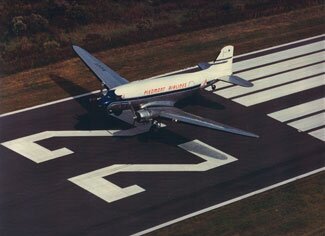
Launched in 1948 from Winston-Salem, Piedmont originally linked North Carolina to the Ohio River Valley with an all-DC-3 fleet. By time of its 1989 purchase by U.S. Air, Piedmont was the nation's sixth largest airline, with flights to London, California, and the Bahamas.
CAROLINAS AVIATION MUSEUM
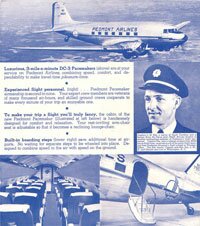
Until the accident, Piedmont had a blemish-free safety record– unless one counts the June 13, 1956 incident over Shelby, North Carolina, when honeymooner Oren A. Pruitt of Charlotte, thinking he was entering a restroom, mistakenly opened the exit and fell to his death.
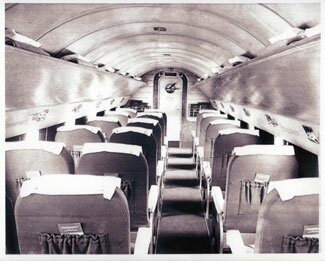
The 24 seats of Flight 349 were arranged in eight rows. The survivor had the seat at the far right rear of the plane (not shown).
CAROLINAS AVIATION MUSEUM

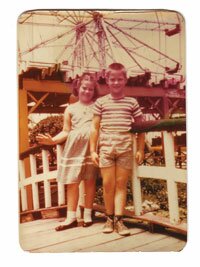
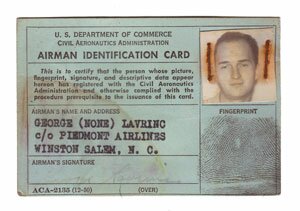
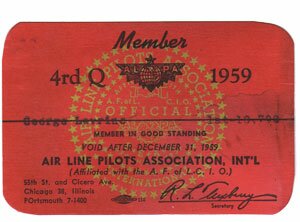
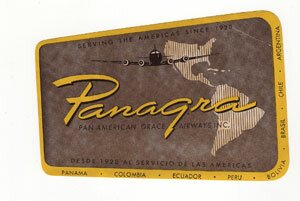
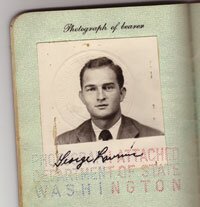
Pilot George W. Lavrinc met his future wife, Bonnie, in South America where she took reservations for Braniff and he manned radios for Panagra. They married in Ecuador, but after two children and his transfer from Norfolk to Arlington, the marriage suffered.
COURTESY WAYNE LAVRINC
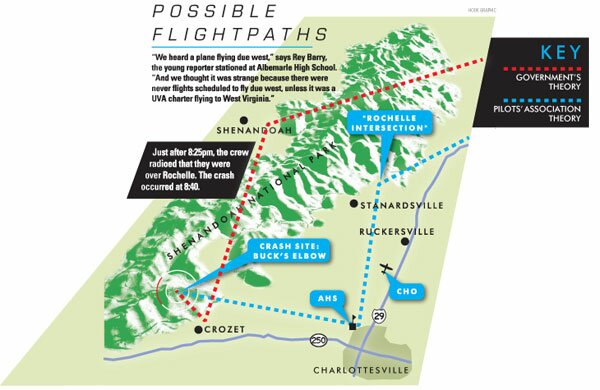
"We heard a plane flying due west," says Rey Barry, the young reporter stationed at Albemarle High School. "And we thought it was strange because there were never flights scheduled to fly due west, unless it was a UVA charter flying to West Virginia."
Just after 8:25pm, the crew radioed that they were over Rochelle. The crash occurred at 8:40.
HOOK GRAPHIC
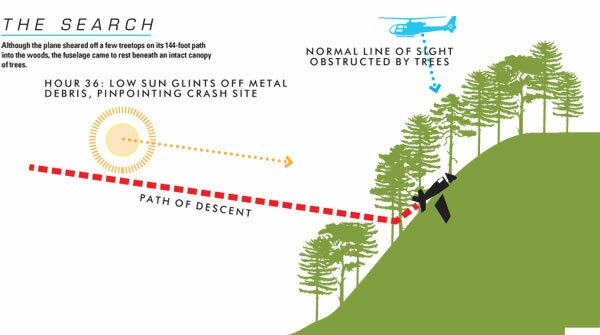
Although the plane sheared off a few treetops on its 144-foot path into the woods, the fuselage came to rest beneath an intact canopy.
HOOK GRAPHIC
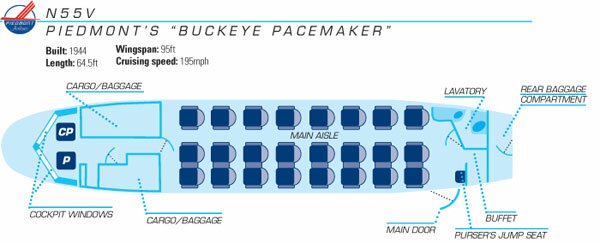
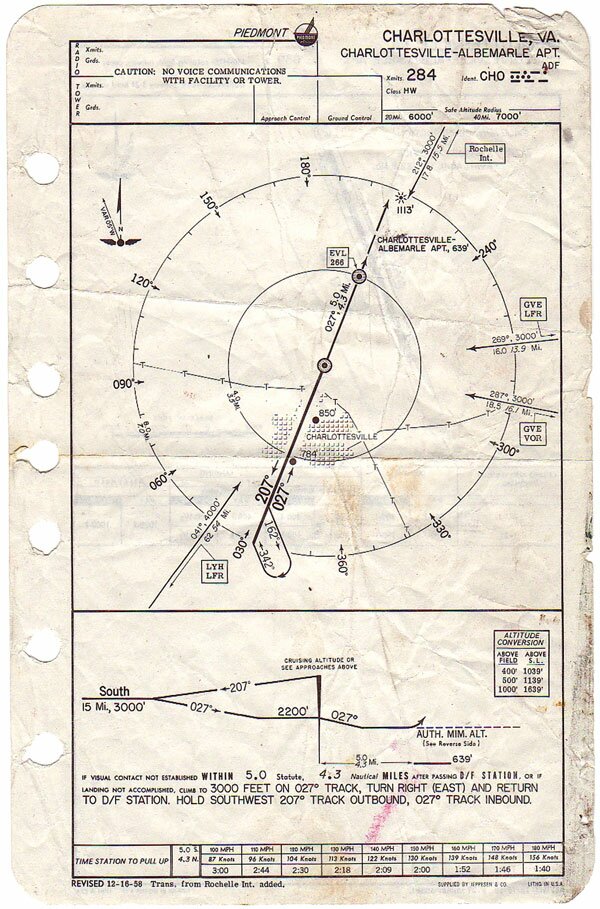
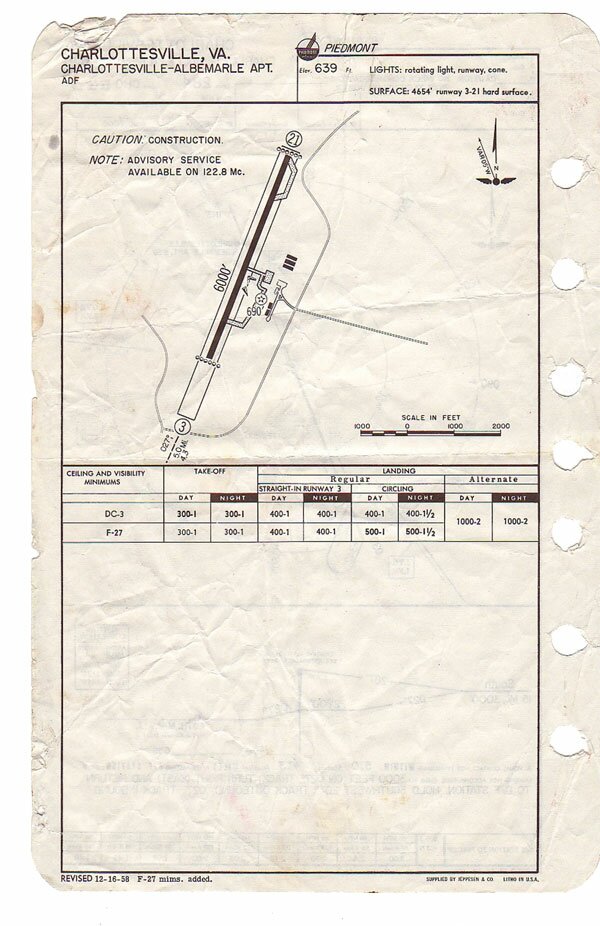
Piedmont's circa 1959 landing instructions for the Charlottesville-Albemarle Airport show a procedure turn of over 180 degrees.
COURTESY WAYNE LAVRINC
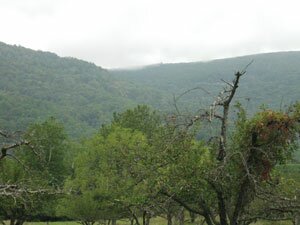
The plane crashed at an elevation of 2,515 on 3,180-foot Bucks Elbow Mountain, which towers above the orchards of Crozet.
HAWES SPENCER
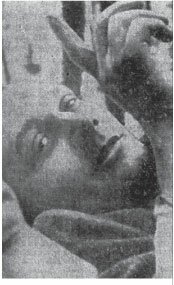
This photo of an on-his-way-to-the-hospital Bradley won a national award for the Lynchburg News and Daily Advance.
LYNCHBURG NEWS & DAILY ADVANCE
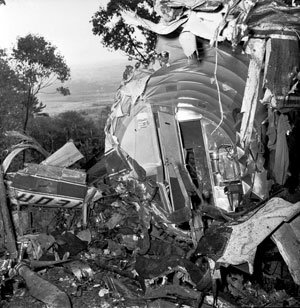
For 36 hours, this shattered fuselage was part of the survivor's view– only with multiple bodies. (Note restroom door at left rear and purser's jumpseat at right rear.)
RIP PAYNE COLLECTION, ALBEMARLE CHARLOTTESVILLE HISTORICAL SOCIETY
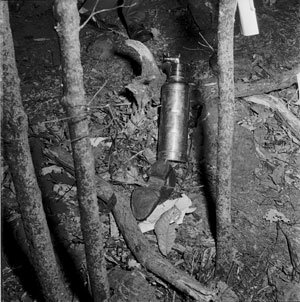
Mechanical and passenger debris, including dozens of shoes, littered the area.
RIP PAYNE COLLECTION, ALBEMARLE CHARLOTTESVILLE HISTORICAL SOCIETY
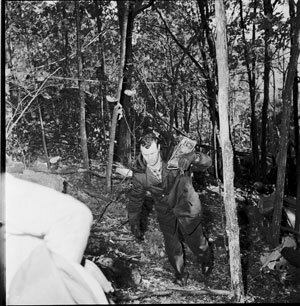
An investigator retrieves an electronic component for analysis.
RIP PAYNE COLLECTION, ALBEMARLE CHARLOTTESVILLE HISTORICAL SOCIETY
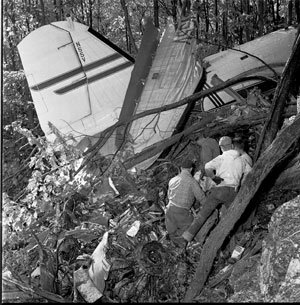
The tail was the only section of the DC-3 to remain intact.
RIP PAYNE COLLECTION, ALBEMARLE CHARLOTTESVILLE HISTORICAL SOCIETY
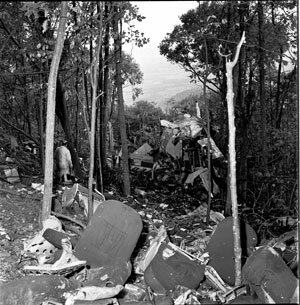
All 24 passenger seats ripped away from the cabin floor.
RIP PAYNE COLLECTION, ALBEMARLE CHARLOTTESVILLE HISTORICAL SOCIETY
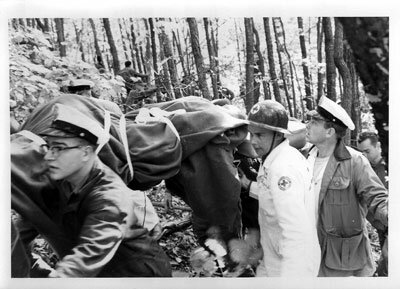
The terrain was so steep that rescuers ferrying bodies up to the peak tied a rope to the trees to aid the climb.
RIP PAYNE COLLECTION, ALBEMARLE CHARLOTTESVILLE HISTORICAL SOCIETY
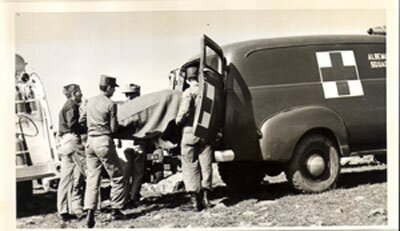
Atop the cleared peak of Bucks Elbow, bodies were transferred to ambulances.
RIP PAYNE COLLECTION, ALBEMARLE CHARLOTTESVILLE HISTORICAL SOCIETY
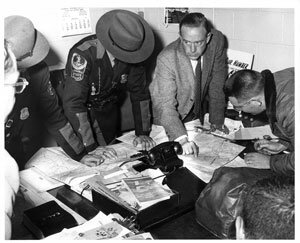
The ground search was coordinated by the State Police and the Civil Air Patrol before the Air Force arrived with helicopters.
RIP PAYNE COLLECTION, ALBEMARLE CHARLOTTESVILLE HISTORICAL SOCIETY
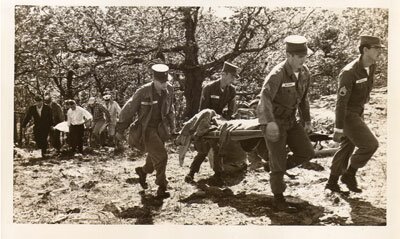
The Monticello National Guard and dozens of local fire and rescue teams assisted in the recovery effort.
RIP PAYNE COLLECTION, ALBEMARLE CHARLOTTESVILLE HISTORICAL SOCIETY
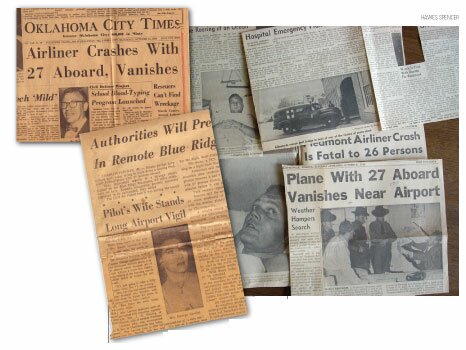
The story of a missing plane in Virginia gripped the nation.
HAWES SPENCER
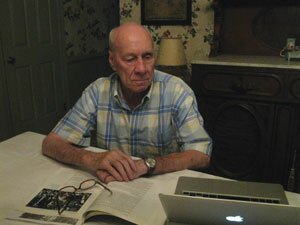
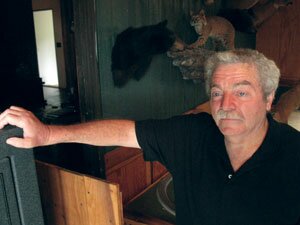
Alvin Toms was a 22-year volunteer firefighter tapped to guard the wreckage Sunday night. Warren Seale was the 12-year-old whose grandfather heard a boom that Friday.
HAWES SPENCER
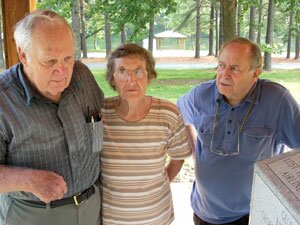
Sole survivor Phil Bradley, shown here with wife Zella and former newsman Rey Barry, dedicated a monument to the crash in Mint Springs Valley Park 10 years ago. He'll return for another ceremony at 10am Saturday, October 31–- 50 years and a day after the disaster.
HAWES SPENCER
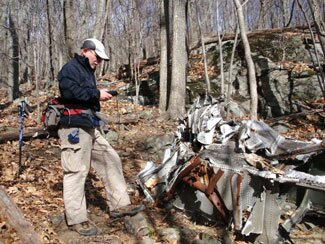
Richmond-based hiker Bryce Allison, shown checking his GPS at the wreckage last winter, plans to lead another hike to the site after the October 31 ceremony.
COURTESY BRYCE ALLISON
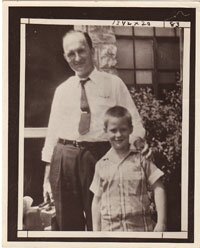
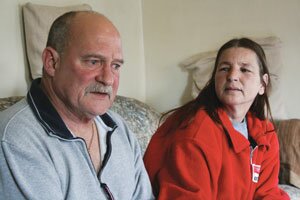
Wayne Lavrinc, seen right as a boy with his pilot father and above with his wife Jolynn, learned only this year of the alternate crash theory.
COURTESY WAYNE LAVRINC; HAWES SPENCER
#
33 comments
Powerful,you were there account of death, and survival, exquisitely set in time and place, 1959 Charlottesville, Virginia. A marvelous history of aviation in this period, with gripping archival pictures and documents. This is reporting and writing at it's best--great job Mr. Spencer.
I am the daughter of the co-pilot, Lee Haley and would like to thank you so much for your time and effort involved in this. You've given me so much information I never knew! An absolutely wonderful job.
Is there any way I can get a copy of this issue?
You did a fabulous job reporting the tragic events of this crash, Mr. Spencer. I am the grandaughter of Julian Nardi, the pipeline engineer from Ford, Bacon & Davis that died in the crash. I never knew my Grandfather as I was born in March of 1962.
I hope to make it out to the memorial from Colorado. Thanks for your hard work on this piece. I too, would like a copy of this issue if possible.
Thank you for the wonder article about the accident. Like my dear cousin Ellen, I am one of Julian Nardi's grandchildren. I wish that I could come out for the memorial, but I will not be able to make it. I send my thoughts and prayers to all those families that have been effective by the accident.
Thanks!
I have mixed emotions about all this. I never knew my Dad. In fact Dad seems like a strange word that everyone ELSE uses. I would have liked to get to meet him...do what sons and Dads do. Flight 349 changed all that. I feel blessed in a way, some kids grow up with a dad thats hateful and abusive. Or cheats on his wife. Bascom Lee Haley was an excellent instrument flyer in the Air Force, and someday hoped to fly with Delta. Something unusual must have gone on that night when that plane got so of course and it will remain a mystery. I'm I bitter? Somewhat. I wanted a Dad. My Mother never married again and I understand why now. Lee Haley was a fine man. One I believe any woman would hold on to. That's what she did until the day she died. I went through bitter periods in my life where I needed closure. Closure at Bucks Elbow Mountain. The first words I remember hearing from my mother is, "Your Fathers dead. The plane he was flying crashed into a mountain. The instruments were wrong..." For a child, that sets up a strange and curious life. Obsession set in and all I wanted to know about was how my Dad died...I imagined a ripped and torn body blasting into a mountain side at breakneck speed, parts flying everywhere. my dad. I'm sure it didn't hurt and they didn't know it was coming, but I wanted to know every detail. Death to me was mysterious. My uncle told me in later years that all they found was..my Dad..from the waist down. Quite a vision for a son. His wallet and personal effects were returned to my mom in a brown greasy paper sack. Well, the one thing that Dad left behind was an 8mm camera and projector Mom kept in the attic. It was something Dad had and by experimenting with it, I have become a professional cameraman and videographer. I hooked up with Phil Bradley and Phil provided a unique calming closure to this horrible event. Someday soon I'd like to gather all the necessary elements together and with filmmaking expertise, share this with the world. I think Dad would have liked that...
My father, David W. Findlay, who was on the plane, was the Sales Mgr. for WDBJ TV in Roanoke. Since Daddy had been the Sportscaster on the evening news before he became the Sales Mgr., he was a local celebrity. So the crash was big news around town. Thank you for caring enough to take the time to do the in-depth research that others have failed to do. So much of this, no one knows. I have the CAB report, but frankly, the ALPA report seems more logical and makes much more sense to me. So much wonderful information! I'm very disappointed that I won't be able to attend the ceremony on the 31st and meet others who were affected by the accident, but my family will be well represented by my sisters. Thank you again for all the work you did and for contacting me.
When I was a Piedmont pilot back in the middle 1960's based in Norfolk Virginia. I spoke to Bonny one night on the crew room phone. She had called just before I was going out on my scheduled trip. As she spoke she had a strange aura about the way talked. (Maybe alcohol) She told me who she was and wanted to speak to Piedmont pilots that were not there that night. I told her that I was sorry but none of those pilots were available. She told me to fly carefully and hung up. I told the Captain of my flight about the call and he said, "She call's all of the time.)
The Hook has done a great job with this story snd very thorough. A timely piece for the sole survivor Mr. Bradley and for the relatives of the crash victims as the 50th Anniversary Service approaches in just a few short weeks.
Excellent story and graphs and maps. The tragedy obviously effected many lives.
I still cant understand how on a 110 mile flight a plan was 15 miles of course (distance from CHO to Bucks Mtn). You did an good job of exploring possible theories.
My wife, Ellen Findlay Cowan, has talked about this since we have been together, over 30 years. We have been to the memorial site, but did not try to reach the crash site. In an interesting side note, Ellen got a call from the neighboring Brandermill area. it seems that the son of one of the deceased passengers had been adopted as a child,and his wife told her he only recently learned about the crash and about his real father. Even strange that they live only 10 minutes from us.
The detail in this article is impressive. And I do believe the man saw christ!
This is the most detailed account of the tragedy I have ever read. Brings back many memories of that weekend. I note that the map of possible flight paths indicates Rochelle west of U.S. Route 29. Rocehelle lies east of 29.
This is an excellent article. My family and I had heard of the crash and its sole survivor when we first came to Charlottesville, but until now we had not heard the whole story or the various theories as to its cause. It was indeed a terrible tragedy.
I am interested to know whether Warren Seale's father was/is the same Mr. Seale who helped avert another tragedy in January of 1981, when three young Scouts went missing overnight in near-zero temperatures on the mountain near Humpback Rock. Mr. Seale and Mr. James Wood, two of the hundreds of volunteers who searched through much of that night, refused to leave the mountain when the search was officially suspended "until morning." A small group under their leadership found the boys -- cold and tired, but unhurt.
Mr. Seale, was/is this your father? I am sorry that I have forgotten the man's first name.
I referenced this event on wikipedia and the article cites "mental stress" of the pilot as the reason for the crash. Hopefully, that record and the official one will be amended. This was a great story and another like it is in the October issue of the Crozet Gazette. More pictures are there, too. (Thanks for the link posted to cvillenews.com)
I talked with a gentleman today who was in his 30's living in Charlottesville at the time. He said, he remembers the night of the crash well, and because he was a frequent flier, he noticed the very low cloud cover, and was not surprised to hear there had been a plane crash on that night, given the bad weather conditions for flying.
Interesting story. More interesting to me was seeing the cover. That is my painting "DC-3 Into Denver" by renowned aviation and western artist, Dave Paulley.
This painting is depicts a Frontier DC-3 descending over the front range into Denver. I had the honor of flying for Frontier for many years. Frontier had the best safety record in the world-wide history of civil aviation based upon the most stringent measure, that of the number of take-offs and landings. So, it is with some chagrin to see it on the cover of a book attributed to a fatal accident!
I have bought and sold many paintings, and I am thrilled to be introduced to the work of Dave Paulley. Unless this painting had appeared on the cover of my local magazine I would never have seen it. This is a beautiful, haunting painting. I would love to see the original Mr. Walker. If you ever loan it for a museum show, please inform this weekly. so we in the East may have the chance to view it in person. You are a lucky man to own such a fabulous work of art !
Very well done.
The navigation issues in the story bring up more questions than answers.
Not to quibble with a comment made above, but "Rochelle" was an intersection on the low altitude airway, V-140. These intersections were frequently named after towns in the vicinity, and were not directly over them, thus the discrepancy.
Hawes has done a really wonderful job at putting all this research together in such an interesting format. A big thanks to Bryce Allison for his web pages, which helped others and me find this plane and stories about the relatives.
I had remembered that night in high school. We wanted to help in the search, but rescuers were not interested in untrained high school students. All they needed was some lost students to make matters worse. They were right, Bucks Elbow is one tough climb.
Today, 50 years of leaf mulch hides most of that debris. The biggest part is a wing seen in the photo with Bryce. Close to the final resting place is a ledge…it has the best view of Crozet.
I feel so bad for the people who lost their lives,and for the people who knew smoeone who had their lives taken from them. i want to send a special sorry for thoses of whom we speak. a men to them.
An outstanding story showing the event from several perspectives. Thanks for your efforts.
I was living in Amarillo, Tex. when I heard about the crash on TV. It was a shock because I knew Phil Bradley and his brothers, Ed and Carter. I too, was born and reared in Clifton Forge, VA. All three of the Bradley boys were wonderful football players. After Phil wrote his book, he contacted me in 1997 to ask if I wanted to purchase a copy, having gotten my address from the Class Reunion Committee. Of course I did and was fascinated as I read it. He and I have kept in contact ever since and have become very good friends even though we have never seen each other since 1943, when he went in the Navy and I moved to California. You will never meet a finer gentleman than Phil Bradley.
I thoroughly enjoyed your coverage of such a horrific event. Thank you for your careful attention to detail.
You have done a great job organizing and telling this story of a great tragedy fifty years ago. I talked to Phil Bradley several days ago and have invited him to visit me on Buck's Elbow. I hope to be present at the memorial service on October 31st at Mint Springs.
I am the pilot who decided to re-enact the government’s flight path theory in July, 2009. I did this to collaborate with Hawes Spencer for his article. After reading the reports and making the flight, I am very skeptical of the government’s findings and theory as to why the accident occurred, based upon their own “facts”.
I too will be at the memorial looking forward to meeting Mr. Bradley and surviving family members of the passengers and crewmembers. In particular, by making this flight, I hope that there may be some closure for them, as to whether or not the official report from the government was indeed sufficiently accurate to have closed the accident file.
Fifty years ago, my father, Ed Gill, was searching the mountains of Amherst County for Flight 349. Dad had a keen interest in the outcome, as he worked for Chapstick and knew one of the eventual victims, Mr. Whitehouse. When the announcement that the wreckage had been found came over the radio, Dad drove to the Crozet area and hiked to the site. He took his home movie camera and filmed 65 seconds of silent, color footage of the recovery effort. The video clearly shows the downed plane, military personnel, and victims being removed from the site. I recently converted the footage from reel-to reel tape to DVD. Perhaps I'm wrong, but I imagine that color video of Flight 349's aftermath is somewhat rare, and I consider it an honor to possess such an item.
Thank you, for sharing this piece of Virginia history with all of us.
My father, Wesley R. Ely, was one of the passengers on this flight. Although my mother, MaryE Marks Ely, spoke very little of the horrible event on Oct. 31, 1959, it was, of course, one that shaped my life. I was three when Dad was killed. I visited the memorial at Buck's Elbow in 2008 for the first time. Thank you, Mr.Bradley, for your work to keep the memory of victims of Flight 349 alive. The memorial is a beautiful, peaceful, and healing spot to visit. Thank you, also,Mr. Spencer for this wonderful article. I wish I could be there for the 50 year memorial celebration. My husband, Bob, and I are serving as ELCA Lutheran missionaries in Tanzania, East Africa. May God bless you all, especially, those who, like me, who are family members of those who died on that lonely mountain Oct. 31, 1959.
This morning’s tribute to those deceased was a fitting memorial to the 50th anniversary of the crash. I had the opportunity to meet a number of surviving family members and relate to them what I found on my retracing of the flight path as published in the official CAB findings and whether or not the flight could have taken that path.
There is more work to be done on continuing to find the real cause of the tragedy, as the CAB used speculative information to close a case that should have been investigated further so as to not place blame on the flight crew based on the lack of facts presented.
I hope to bring closure those families who are still wondering how this tragedy could have occured.
My father, Robert Stith Northington along with his college roommate, Tom Davis, started Piedmont Airlines. I grew up in Winston-Salem but have lived in Keswick, Virginia for 33 years. Thanks for a wonderful article.
Believe or not, but this was the second airplane to crash on Buck Mountain; the first was a USAF plane coming back to Washington,DC's Bolling AF Base loaded with 28 cadets and cadettes from the elite George Washington University's AFROTC UNIT. Out of 28 students and three crew members only 5 survived. This crash just happened to be on the side of Buck Mountain which had down below, a grass landing strip used by locals flying Bi-planes. Just above where Buck Mt Rd and Catterdon Rd intersected. This crash happened on Sunday evening, Nov.2,1958
How do I know? I'm one of 2 known survivors.
Great article! I will have the awesome priviledge of flying Mr. Bradley and a few other friends to Charlottesville on May 5th in a Piedmont Airlines DC-3 operated by the Carolina's Aviation museum in Charlotte. I have hiked to the crash site and look forward to flying over it in N44V next week!
Please check out the Facebook page dedicated to the Crash of Flight 349 in Virginia. We welcome comments and additional information about the crash and the people it affected.
Thanks for all the information. Do you know if Bryce Allison has the gps track to the site in .gpx or .gdb format that he would be willing to post?